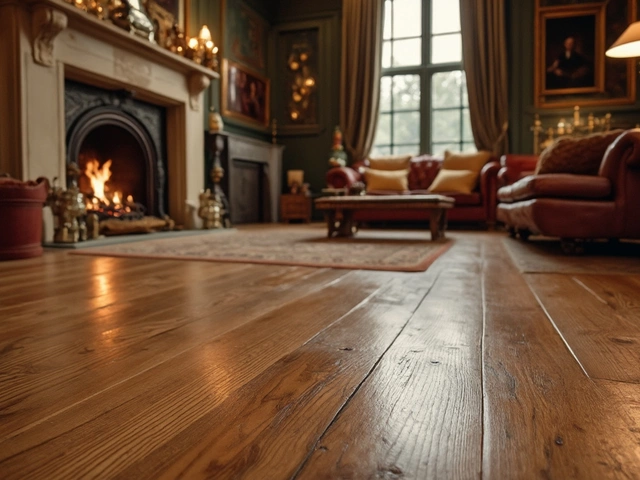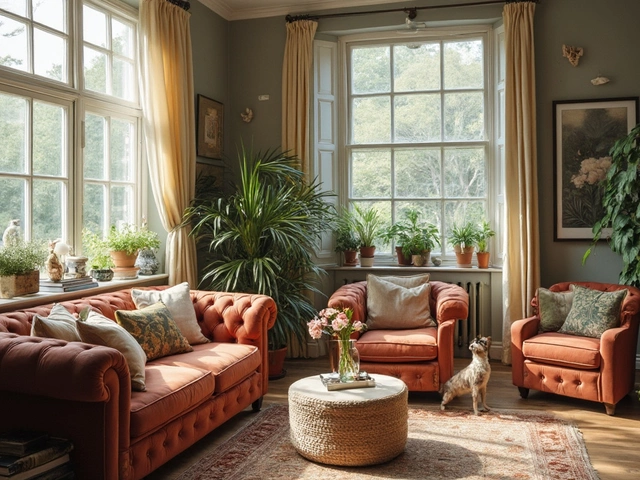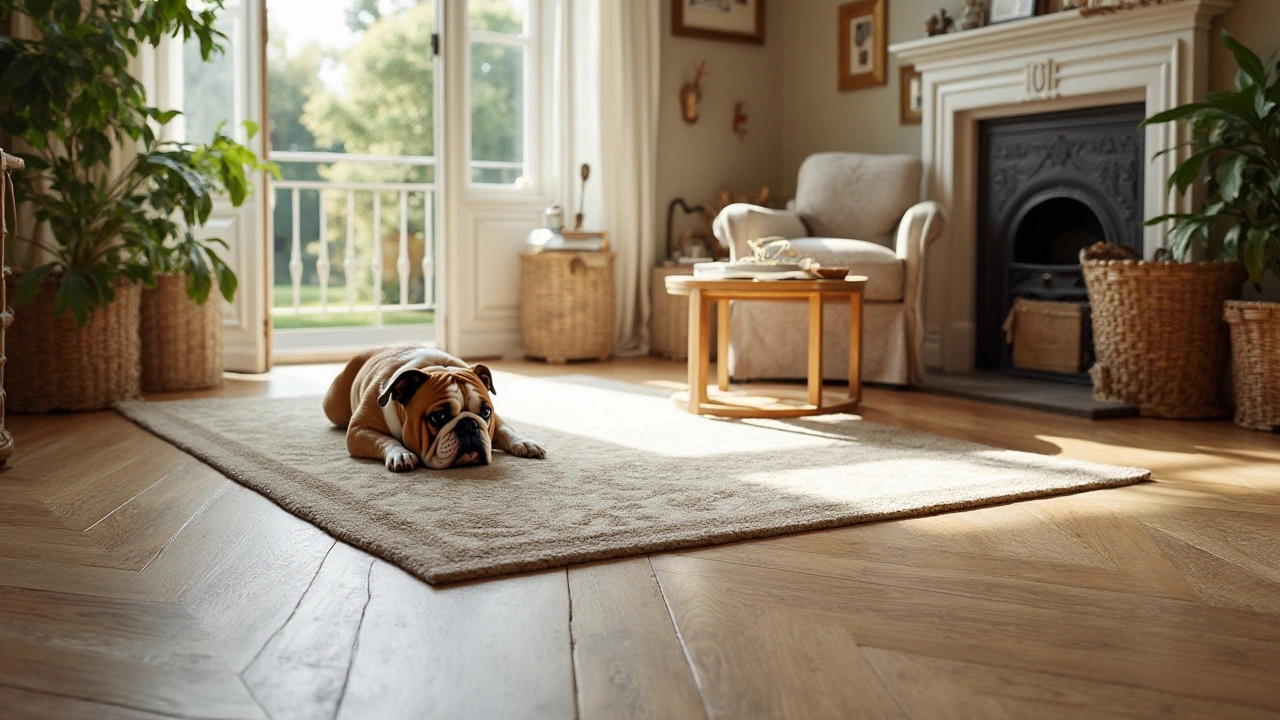
Revamping your floors can quickly become a costly endeavor, but it doesn't have to be. Many affordable flooring options are available that combine style, durability, and budget-friendly pricing, making them perfect for any home update.
Whether you're interested in the classic allure of hardwood or the modern versatility of vinyl, you’ll find a variety of options to suit your taste and budget. Each type of flooring brings its own benefits, from waterproof and easy-to-clean surfaces to those that mimic the appearance of pricier materials.
Diving into these choices with an informed outlook can help you make the most of your space without spending a fortune. Explore some of the best budget-friendly flooring solutions that will make your home beautiful and enduring.
- Understanding Flooring on a Budget
- Vinyl: Style Meets Affordability
- Laminate: The Look of Wood for Less
- Cost-Effective Carpet Choices
- Opting for Linoleum and Its Perks
- DIY Tips for Saving More on Flooring
Understanding Flooring on a Budget
The journey to upgrading your home’s flooring while sticking to a budget can seem daunting at first. However, with a little planning and understanding of the available options, it's entirely possible to achieve a balance between cost and aesthetic appeal. When you're working with a limited budget, the first step is recognizing that affordable does not equate to unattractive or low-quality. Modern budget flooring options have evolved significantly, offering homeowners a variety of styles and textures to choose from without the hefty price tag typically associated with traditional materials.
One of the first considerations when searching for cheap flooring solutions is understanding the lifespan and maintenance requirements of each type. Many affordable options like vinyl and laminate offer surprising durability, making them ideal for busy households. Being mindful of installation techniques can also lead to savings. Some types of flooring, like click-lock laminate, are designed for straightforward DIY installation, which can save you a considerable amount of money on professional installation fees. According to a survey published by the National Association of Home Builders, nearly 50% of homeowners undertake DIY projects to manage costs effectively.
When choosing budget flooring, it’s important to consider not only the immediate cost but also the potential for added value to your home. Certain materials like laminate can closely mimic more expensive options like hardwood, giving your home a high-end look at a fraction of the cost. Furthermore, many of these cost-effective materials are engineered to withstand heavy foot traffic and are resistant to scratches and stains, which can prolong their appeal. In the words of home renovation expert Bob Vila,
"The key to successful budget home improvement lies in understanding how to maximize quality within your financial limits."
Finally, setting a clear budget before starting your flooring project will help you keep track of expenses and explore options without overspending. Creating a list of your priorities, such as moisture resistance for kitchen or bathroom floors or comfort underfoot for living areas, can guide your selection process. By doing so, you ensure that the flooring choices you make align with both your practical needs and stylistic preferences. Remember, the cheapest option is not always the best one, but the right choice will offer a winning combination of price, durability, and visual appeal.
Vinyl: Style Meets Affordability
When it comes to achieving a stylish look without the heftier price tags associated with other flooring materials, vinyl stands out as a versatile champ. This budget-friendly flooring option has captivated homeowners with its remarkable ability to mimic the appearance of more expensive counterparts like hardwood or stone. Thanks to advancements in technology, vinyl now offers an impressive range of patterns and textures, making it a top contender for those looking to balance cost with aesthetics.
Vinyl flooring comes in sheets, tiles, and planks, each allowing for varying degrees of creativity and application. Luxury vinyl planks (LVP), for example, replicate the elegant look of wooden floors but are resilient to moisture, making them ideal for areas like kitchens and bathrooms. According to a report by The Flooring Manufacture Alliance, vinyl's market share continues to grow steadily, thanks to its cost-effectiveness and ease of installation.
"Vinyl flooring has transcended its humble beginnings to become a sophisticated choice for modern homes," notes interior design expert Lisa Aldridge.This sentiment is reflected in the numerous choices available that don't just offer affordability but also are laden with practical benefits.
Regarding durability, vinyl is known for its excellent resistance to wear and tear, an essential quality for high-traffic areas. It is constructed with a wear layer that protects from scratches and scuffs, which, depending on the product, can cater to both residential and light commercial environments. The water-resistant nature of vinyl is another compelling draw, particularly for families with young children or pets. Spills are much less of a crisis, as vinyl can simply be wiped clean, retaining its beauty with minimal fuss. For those looking to minimize downtime, vinyl is a blessing due to its straightforward installation process. Often utilizing a click-and-lock mechanism or adhesive backing, homeowners can install vinyl flooring over existing surfaces, saving time and money on preparation work.
As a part of the sustainable revolution in home design, some vinyl options now boast eco-friendly features, such as being manufactured with low VOC emissions, which contribute to better indoor air quality. In terms of longevity, although vinyl isn’t impervious to damage, proper maintenance can ensure it lasts upwards of 10 to 20 years. The initial savings coupled with its lifespan make it a truly enticing option for budget-conscious individuals looking to enhance their homes.
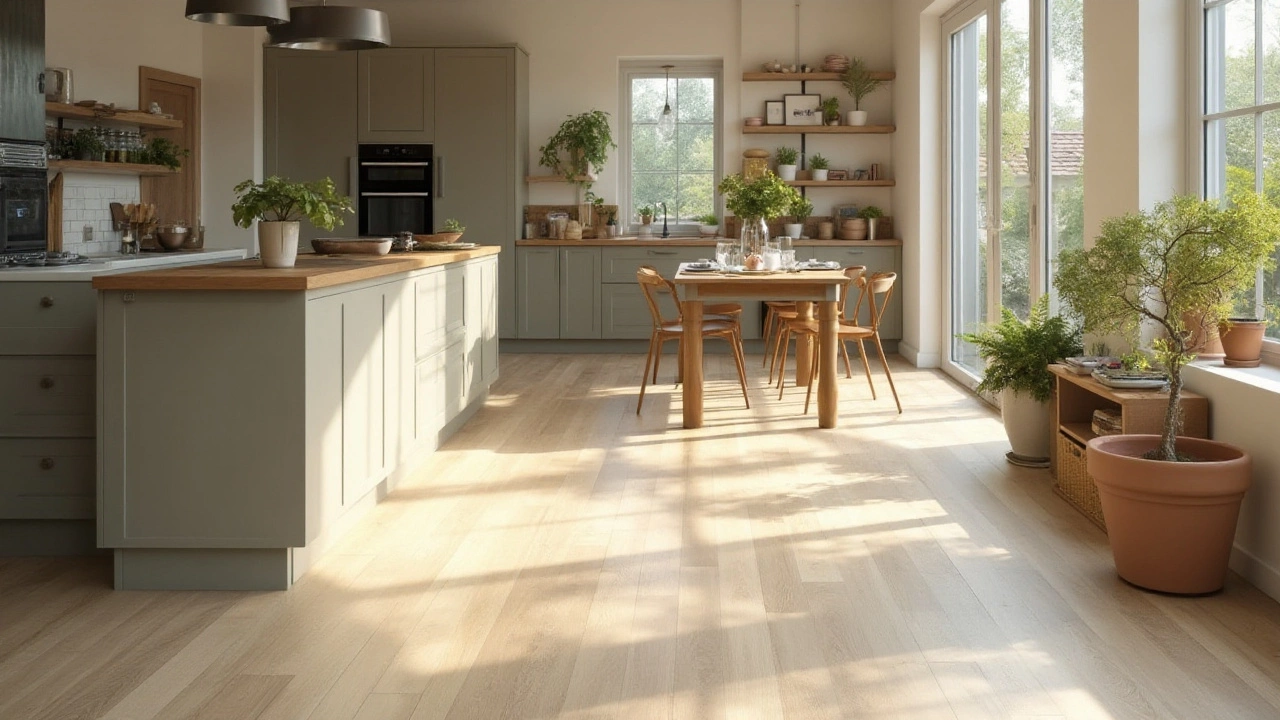
Laminate: The Look of Wood for Less
When dreaming of hardwood floors but deterred by the cost, laminate flooring emerges as an attractive alternative. Known for its ability to mimic the appearance of real wood with remarkable authenticity, laminate has undergone significant advancements over the years. Now, it delivers durability and aesthetics that make it a staple in homes seeking budget flooring solutions. Laminate is crafted through a high-density fiberboard core, topped with a photographic appliqué layer, which is covered by a protective melamine resin. This construction not only makes laminate sturdy but also incredibly resistant to scratches and dents, which is a huge plus for households with pets and children.
The allure of laminate flooring doesn't end at its durability. Its ease of installation is another big win for those looking to update their homes without professional help. With a click-lock design, laminate boards are usually installed as a floating floor, not requiring nails or glue. This feature makes it a popular choice for DIY enthusiasts. According to the World Floor Covering Association, DIY installations can save homeowners up to 50% on total flooring costs. An added bonus is that laminate doesn't require the same level of maintenance as real wood. There's no need for sanding or refinishing, just regular sweeping and occasional damp mopping to keep it looking fresh.
Despite its budget-friendly nature, laminate flooring doesn't skimp on variety. Available in countless styles, colors, and textures, it can suit any décor—from rustic cabins to chic modern apartments. This flexibility makes it a go-to option for various design preferences. As the market grows, newer styles of laminate floors have incorporated embossed textures that replicate the grains and knots of real wood, further enhancing their authenticity.
“The genius of laminate flooring lies in its transformative ability to capture the true essence of wood, yet surpass it with practicality,” notes interior designer Sarah Richardson.
Another aspect often overlooked is laminate flooring's environmental friendliness. Many options are manufactured using materials that promote sustainability. Additionally, they tend to be hypoallergenic, thanks to their installation method that reduces gaps where dust and allergens can hide. It's worth noting that while laminate is often water-resistant, it's not waterproof, so it wouldn't be advisable in areas with heavy moisture like bathrooms or basements without moisture barriers. That said, it still holds up well in kitchens and other high-traffic areas. The affordability of laminate flooring, combined with its versatility and resilience, makes it a standout choice for anyone prioritizing both style and budget in their home improvement ventures.
Cost-Effective Carpet Choices
When it comes to adding warmth and comfort to a space, carpets often steal the show, but many homeowners worry about the expense involved in choosing this flooring option. Fortunately, there are plenty of budget flooring solutions in the realm of carpets that don't compromise on style or performance. Carpets made from synthetic fibers like polyester and olefin can offer a luxurious feel underfoot without the hefty price tag. Polyester carpets, for instance, are celebrated for their vibrant color retention and softness, making them a popular choice for families looking for an affordable yet attractive option. Meanwhile, olefin, also known as polypropylene, is known for its resistance to staining and moisture, perfect for areas prone to spills and foot traffic.
When selecting an inexpensive carpet, the pile type also plays a significant role in both appearance and longevity. Berber, with its looped fibers, tends to be more durable and stain-resistant, an excellent choice for high-traffic areas without a prohibitive cost. Saxony, on the other hand, offers a plush feel that is perfect for formal settings where comfort takes precedence. Often, retailers also offer remnants or end-of-roll discounts, where high-quality carpet pieces are sold at a fraction of the price, allowing for significant savings if you're crafty with installation. According to a report by the Carpet and Rug Institute, "Carpet continues to be the largest category of flooring used in American homes, leading to a myriad of options for economic choices."
Maintenance is another aspect where certain carpets distinguish themselves in the long run. Routine vacuuming and periodic deep-cleaning can drastically extend the life of budget carpets, ensuring they stay looking fresh and inviting for years. Many manufacturers today apply stain-resistant treatments to their carpets, which makes caring for them simpler and more effective. It's also valuable to opt for neutral colors and patterns, which not only help disguise dirt and wear but also work harmoniously with a variety of decor styles, ensuring the carpet remains a viable option should you choose to redecorate. A table below illustrates some common cost-effective carpet types and their key features:
| Carpet Type | Key Features |
|---|---|
| Polyester | Affordable, vibrant colors, soft texture |
| Olefin | Stain-resistant, moisture proof, ideal for high-traffic areas |
| Berber | Durable, stain-resistant, looped pile |
| Saxony | Plush, luxurious feel, suitable for formal rooms |
Choosing the right carpet doesn't just boil down to cost, it involves considering lifestyle, the space's purpose, and your unique aesthetic preferences. Armed with the knowledge of what the market offers, anyone can make a smart decision when it comes to cost-effective carpet choices that enhance the home's atmosphere while keeping the budget intact. Whether you prioritize ease of maintenance, the warmth and coziness factor, or simply the best bang for your buck, the right carpet is out there waiting to be discovered.
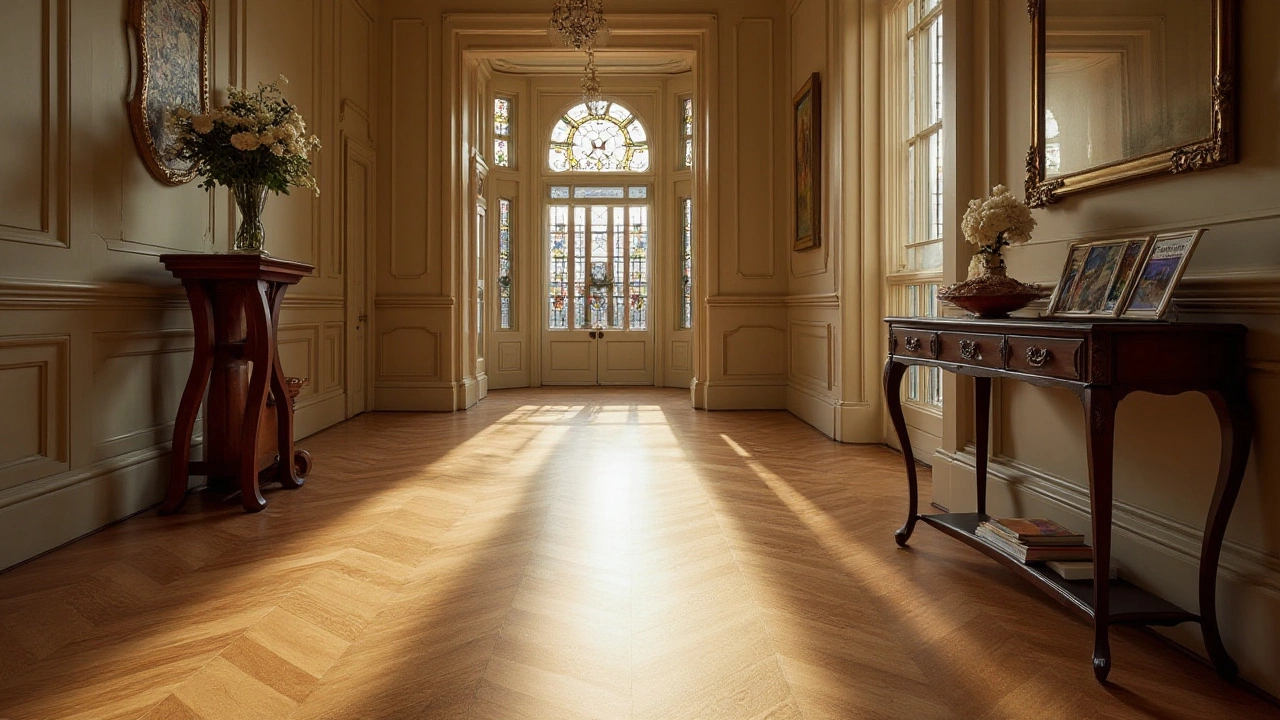
Opting for Linoleum and Its Perks
Linoleum is one of those flooring materials often misunderstood and overshadowed by its synthetic counterpart, vinyl. Interestingly, linoleum has been around for over 150 years, originating as a natural, biodegradable solution. Made from renewable resources like linseed oil, cork dust, and wood flour, it’s both an eco-friendly and cost-effective option—qualities that appeal to the budget-conscious homeowner looking to improve their space without accumulating a large carbon footprint.
One of the notable benefits of linoleum is its durability. When properly maintained, linoleum floors can last up to 40 years. This longevity makes it a sustainable investment, often outlasting cheaper synthetic materials. Additionally, it's naturally anti-static and antibacterial, making it an ideal choice for homes with allergy concerns or those requiring extra germ control. Unlike some other budget flooring options, linoleum possesses a 'bounce-back' quality that helps it recover from minor dents and impressions, meaning it retains its attractive look over time.
Aesthetic versatility stands as another strong suit for linoleum. Available in a multitude of vibrant colors and patterns, it can mimic other materials, such as stone or wood, without the associated high costs. Its design potential is quite expansive, allowing homeowners to create unique looks. In addition, it can be cut into various shapes to create engaging patterns, providing an artistic touch that other cheap flooring solutions might lack. It's no wonder linoleum is regaining popularity among modern designers and architects.
Installing linoleum flooring can be relatively straightforward, though it requires some skill and precision to ensure longevity. Ideally, linoleum sheets are adhered with glue, allowing for a seamless finish. It's crucial to apply a protective sealant over the surface to safeguard against moisture and extend its life. Homeowners interested in do-it-yourself projects will find linoleum friendly, though not entirely without challenges, as precision cutting and correct adhesive application are paramount.
“Linoleum's resurgence is no accident—it’s a practical, stylish solution for eco-aware consumers,” remarked Jane Doe, an interior design expert from Home Interiors Magazine.
In terms of maintenance, linoleum floors are quite forgiving. Regular sweeping and occasional damp mopping with a mild cleanser keeps them looking pristine. Unlike vinyl, its natural composition means it doesn't readily emit harmful VOCs, making it a healthier choice for indoor air quality. If cost is a prime concern, it’s worth noting that on a comparable scale, linoleum often competes with mid-range vinyl, but its lifespan and eco-friendliness might provide more value in the long run. For those prioritizing aesthetic, eco-friendly credentials, and durability along with their financial plans, linoleum emerges as an attractive flooring option.
DIY Tips for Saving More on Flooring
Embarking on a flooring project yourself not only saves money but also gives you a sense of accomplishment. Start with a clear plan. It's essential to measure your space meticulously to avoid unnecessary purchases. Overestimating means you'll buy more material than required, leading to wastage both in space and budget. Use online calculators or apps that can help you gauge the exact amount of flooring needed. Always account for minor errors by adding a little extra, but be mindful not to overdo it. As you shop for materials, consider buying second-hand or end-of-line products. They are usually available at a fraction of the cost yet offer the same quality.
Preparation is critical. A well-prepared subfloor ensures longevity and a professional finish. Clean the area thoroughly, removing any debris or old adhesives that can affect the new flooring. It's wise to inspect for squeaks or uneven spots and rectify them in advance. Laying a new underlayment is often necessary for leveling the surface and providing additional insulation. Warming up to DIY installations? Focus on floor types that are DIY-friendly. Products like luxury vinyl tiles or click-together laminates are designed for easy installation and typically come with detailed instructions. With these, you can avoid the cost of hiring professionals.
As the project proceeds, invest in or borrow quality tools. A good utility knife, saw, and measuring tape are vital for a seamless job. Proper tools not only facilitate the process but also enhance the final outcome, sparing you from amateur errors. Keep in mind, patience is a virtue. Rushing your work may lead to mistakes, causing damages that could be costly. It’s beneficial to follow online tutorials or guides shared by experts.
"Investing time in learning about the flooring process can prevent most common errors," says Darryl Whitaker, a well-respected home improvement guru.For enthusiasts, joining DIY communities can provide insights and tips from fellow DIY-ers who’ve trodden the same path before you.
Listing out each step can streamline the process, making it more manageable. Here’s a drilling down into the basic steps:
- Carefully remove any existing flooring while salvaging reusable materials like trims.
- Ensure the subfloor is even, clean, and dry before laying down new material.
- Use reliable underlays to add value through better insulation and soundproofing.
- Measure twice, cut once – it's a skill that cannot be overstressed.
- Press into place carefully to avoid bubbles or misalignments, which can crop up over time.
Finally, let's talk about maintenance. Opt for floors that are easy to maintain, not just easy to install. Laminate and vinyl, for instance, are not only inexpensive flooring options but are renowned for their low maintenance needs. Occasional cleaning with appropriate products preserves their beauty and extends their life significantly. Remember, this entire experience is a project you’ll walk on every day, literally and figuratively. By taking these steps and embracing a hands-on approach, homeowners can not only manage costs effectively but also gain the satisfaction of personal creation.


